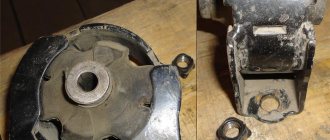The Toyota concern has been producing and installing turbocharged diesel engines on its cars since the last century. The first power unit equipped with a Common Rail fuel injection system was manufactured in 1999. This engine had the index 1CD-FTV. Cars equipped with a similar unit were labeled D-4D. Denso was responsible for the development of the fuel system.
The first modifications of the 1CD-FTV engine were installed on Toyota vehicles until 2006. Subsequently, the power unit was modernized and received the index 1AD-FTV. The 2-liter engine was produced for several years and was distinguished by its reliability and unpretentiousness.
Despite the excellent technical characteristics of the 2-liter D-4D engine, the turbodiesel has characteristic shortcomings and defects. The main trouble for car owners is the fuel system. Denso equipment generally has good technical parameters and works well in tandem with a turbodiesel. But if the fuel system fails, it is difficult and expensive to repair due to its design. The manufacturer did not supply spare parts for injectors and injection pumps for free sale for a long time. The purchase of ready-made kits resulted in a large sum.
On our YouTube channel you can watch the disassembly of a Toyota 2.0 D-4D (1CD-FTV) engine taken from an Avensis with a mileage of 190,000 km.
You can select and buy a Toyota 2.0 diesel engine for Avensis, Corolla, Picnic, Previa, RAV4 on the website.
Design features of the power unit and fuel system Toyota 2.0 D-4D
Depending on the modification, the 1CD-FTV power unit develops power from 90 to 116 horsepower. The engine is equipped with 16 valves for 4 cylinders, the cylinder head is made of aluminum alloy. The engine includes 2 camshafts without hydraulic compensators. The body is made of cast iron, in which the cylinders are bored; there are no liners in the motor.
It is possible to adjust the thermal clearances of the valves. To do this, you need to replace special washers. This does not require dismantling the camshaft. The adjustment procedure is simpler than on other turbodiesels.
The 1CD-FTV engine includes an intake manifold. To reduce air flow turbulence, the system is equipped with a receiver and channels of the same length. This design made it possible to achieve uniform distribution of the incoming flow among the cylinders. A hydraulic tensioner is used to adjust the timing belt. The RS belt controls the operation of the fuel and oil pumps and pumps.
The valve block belt drive is responsible for rotating the exhaust camshaft. The intake camshaft rotates from the exhaust camshaft. Moment transmission is carried out by gear transmission. To reduce the coefficient of friction, the piston skirts are treated with special polymer compounds.
Characteristics
| engine's type | diesel |
| Power | 90 - 116 hp (66 - 85 kW) |
| Torque | 215 - 280 Nm |
| Volume | 1995 cc cm. |
| Design | in-line |
| Fuel type | diesel |
| Fuel mixture | Direct injection |
| Supply system | turbo/charge air cooler |
| timing belt | DOHC |
| Timing drive | Chain |
| Cooling type | liquid |
| Compression | 17.8 — 18.6 : 1 |
| Cylinder diameter | 82.2 mm |
| Piston stroke | 94 mm |
| Number of cylinders | 4 |
| Number of crankshaft bearings | 5 |
| Number of valves | 16 |
The 1CD-FTV engine does not start - what is the reason?
Most often, problems with starting a Toyota D-4D turbodiesel arise due to the fault of the fuel system, namely the injectors and injection pump. But there are other reasons why the power unit refuses to start. First of all, problems may be associated with wear on the starter. Service centers do not immediately pay attention to this unit. Long-term repairs involve checking the injectors and injection pump, after which it comes to the starter.
Even less often, engine starting problems are associated with electrical wiring faults. With prolonged use of the car, the wires gradually fray. Most often, the cables to the intake valve pressure sensor are affected. An error indicates such a defect; the indication is present even when the engine is not running. In some cases, the wires to the engine control unit fray. The readings from the sensors are not visible in the diagnostics.
List of cars with this engine
The motor in question was installed on the following car brands:
Toyota Avensis
- From June 2006 to January 2009 on a second generation Toyota Avensis, restyling, station wagon, T250 body.
- From June 2006 to January 2009 on a second generation Toyota Avensis, restyling, liftback, T250 body.
- From June 2006 to January 2009 on a second generation Toyota Avensis, restyling, sedan, T250 body.
- From February 2003 to December 2006 on a second generation Toyota Avensis, station wagon, T250 body.
- From February 2003 to December 2006 on a second generation Toyota Avensis, liftback, T250 body.
- From February 2003 to December 2006 on a second generation Toyota Avensis, sedan, T250 body.
- From November 2000 to March 2003 on the first generation Toyota Avensis, restyling, liftback, T220 body.
- From November 2000 to March 2003 on the first generation Toyota Avensis, restyling, station wagon, T220 body.
- From November 2000 to March 2003 on the first generation Toyota Avensis, restyling, sedan, T220 body.
- From October 1997 to January 2001 on a first generation Toyota Avensis, liftback, T220 body.
- From October 1997 to January 2001 on a first generation Toyota Avensis, station wagon, T220 body.
- From October 1997 to January 2001 on a first generation Toyota Avensis, sedan, T220 body.
- From October 2003 to February 2009 on the second generation Toyota Avensis Verso, restyling, minivan.
- From August 2001 to September 2003 on the second generation Toyota Avensis Verso minivan.
Toyota Corolla
- From May 2004 to February 2007 on the ninth generation Toyota Corolla, three doors hatchback, E120 body.
- From May 2004 to February 2007 on the ninth generation Toyota Corolla, restyling, hatchback, E120 body.
- From May 2004 to February 2007 on the ninth generation Toyota Corolla, restyling, sedan, E120 body.
- From May 2004 to February 2007 on the ninth generation Toyota Corolla, restyling, station wagon, E120 body.
- From August 2000 to June 2004 on the ninth generation Toyota Corolla, station wagon, E120 body.
- From August 2000 to June 2004 on the ninth generation Toyota Corolla, hatchback, E120 body.
- From August 2000 to June 2004 on the ninth generation Toyota Corolla, three doors, hatchback, E120 body.
- From August 2000 to June 2004 on the ninth generation Toyota Corolla, sedan, E120 body.
- From January 1999 to October 2001 on the eighth generation Toyota Corolla, restyling, station wagon, E110 body.
- From January 1999 to October 2001 on the eighth generation Toyota Corolla, restyling, hatchback, E110 body.
Toyota RAV4
- From August 2003 to December 2005 on a second generation Toyota RAV4, restyling, three doors, suv, XA20 body,
- From August 2003 to December 2005 on a second generation Toyota RAV4, restyling, suv, XA20 body.
- From May 2000 to December 2005 on a second generation Toyota RAV4, three doors, suv, XA20 body.
- From May 2000 to August 2003 on a second generation Toyota RAV4, suv, XA20 body.
Engine problems - possible causes
One of the main problems that a Toyota owner with a 1CD-FTV engine may encounter is a lack of traction, loss of power, increased smoke, and vibrations. In some cases, the engine stalls during the warm-up phase. First of all, an experienced technician pays attention to the condition of the EGR valve, which turns on when the coolant reaches a temperature of 60-80 degrees.
A possible solution to the problem is to clean the EGR valve, as well as the entire exhaust gas recirculation system. If the problem persists, the EGR valve is simply turned off. The characteristics of the motor remain unchanged.
2L tuning options
Almost no one was involved in tuning these engines. You need to understand that the power plant is simply not designed for this and tuning it will not bear fruit, it simply does not have the potential. Yes, you can increase the turbine pressure, but this will give an increase of 5-6 horsepower. It is worth noting that an already loaded engine simply will not survive tuning; its service life will decrease significantly. There are no ready-made tuning kits for the 2L engine series. You can increase the compression ratio by milling the cylinder head and doing porting. This will give an increase of 1-3 hp.
Malfunctions and malfunctions of the turbine
As a turbocharger on two-liter 1CD-FTV engines, a Garrett brand unit with the index GTA17V is used. Such turbines are installed in tandem with engines with a capacity of 110 horsepower. The GTA17V model has variable geometry, is reliable and wear-resistant. Turbine failure is associated with high mileage, as well as the use of low-quality lubricant. The main symptoms of failure are increased oil consumption, extraneous noise and grinding, poor response to pressing the gas pedal.
GTA17V turbines are characterized by a special geometry, which is controlled by a vacuum actuator. If the geometry jams, the turbine overflow is fixed. During diagnostics, the corresponding error codes are recorded. A possible solution to the problem is dismantling, disassembling and cleaning the turbine, namely jammed blades. The shafts must be checked and repaired.
To adjust the geometry, a thrust screw with a lock nut is used. If work is performed by an unqualified repairman, incorrect adjustment may occur. Maximum boost pressure cannot be achieved. In some cases, the geometry control valve also breaks down. Other negative consequences include the appearance of cracks and other defects in the servo hose.
You can choose and buy a turbine for Toyota 2.0 diesel for Avensis, Corolla, Picnic, Previa, RAV4 on the website.
Modifications
Toyota engine factories produced several variants of power units:
- To equip the Avensis sedan, a version of the engine was produced, which was distinguished by less power (90 hp at 4000 rpm). The design uses a turbocharger with a simplified control circuit, a mechanical attachment belt tensioner and a standard generator.
- Power unit for the Rav-4 crossover, developing a power of 110-116 hp. With. The motor is equipped with an adjustable supercharger and automatic change in the tension force of the belt drive.
- Version for the domestic market, found on Previa cars. A special feature of the design is a balance shaft driven by a gear transmission.
Fuel injection pump malfunctions of Toyota 2.0 D-4D engines
The Denso brand fuel system is the main source of problems for the 1CD-FTV power unit. The first generation of engines of this type was equipped with a two-chamber injection pump. Injection was provided by Denso HP2 radial plungers. The next generation of diesel turbo engines was equipped with a fuel injection pump with the Denso HP3 index. The assembly already included one plunger pair. The boost pump on both fuel injection pumps was of the built-in type.
The advantage of the later version of the injection pump was the presence of two electromagnetic-type bypass valves. These elements were responsible for supplying fuel to the system and timely filling of the injection pump. At the suction stage, the solenoid valves opened the fuel supply channel and blocked it during injection.
Any breakdown of the bypass valve leads to a lack of supply of the fuel mixture. As a result, the engine simply does not start. In some situations, a loss of contact is detected in the valve block. In such cases, the power unit also does not start.
The reliability of the Denso fuel injection pump is not satisfactory. With timely maintenance and the use of high-quality fuel, the service life of the plunger pair reaches 300-400 thousand kilometers. Otherwise, there is a reduction in the operating period of the injection pump. The consequence of a breakdown is the inability to start the engine in hot mode after a short stop.
You can select and buy fuel injection pump for Toyota 2.0 diesel for Avensis, Corolla, Picnic, Previa, RAV4 on the website.
Features of D4D direct injection
The engine in question was the first Toyota engine to be equipped with a Common Rail system with direct fuel injection into the cylinders. Unlike this system, the glow plug and nozzle were installed in a vortex chamber, and now the nozzle injects diesel fuel directly into the cylinders.
This power supply significantly improves the technical characteristics of a diesel engine and reduces the emission of harmful substances into the atmosphere. The Toyota D4D was equipped with a Common Rail fuel system from Denso. This is an excellent system, but like any technology it has its drawbacks. This is the complexity of the design and the shortage of spare parts.
The fact is that for a long period of time, Denso did not produce spare parts at all. If something broke, the entire system had to be replaced. This is not a cheap event, and you will have to pay well for the work to replace the system. Due to the complexity of the design, such a problem cannot be solved independently, without the necessary equipment.











